Basic AI Chatbot Pricing: A simple chatbot that can answer questions about a product or service might cost around $10,000 to develop.
Read More

Trying to launch enterprise AI without a solid model is like building a jet engine mid-flight—technically possible, but usually ends in flames.
AI is no longer a futuristic fantasy or a tech team side hustle—it’s a boardroom agenda item. Today, AI model development sits at the heart of how companies create competitive advantage, optimize operations, and unlock entirely new business models. And if you’re still treating it like an “experimental add-on,” you're about to get leapfrogged—fast.
Let’s put this into perspective with what’s happening in 2025:
So Why This Guide?
You’re not here to dabble. You’re here because:
Whether you’re experimenting with AI automation services, launching a pilot, or thinking of hiring experts to develop an AI model in-house, this guide gives you the framework to do it right—from scratch, at scale, and with confidence.
What You’ll Learn:
This isn’t a textbook. It’s a step-by-step enterprise field guide—tailored for CIOs, CTOs, founders, innovation managers, and product heads. Here's what’s inside:
This guide gives you the clarity to make smart calls, the process to avoid failure, and the language to lead with confidence. Let’s move beyond buzzwords and into the boardroom with AI that actually works.
Next up—let’s demystify what AI model development really is.
AI model development isn’t just plugging an algorithm into your system. It’s the process of building, training, validating, and deploying a machine learning or deep learning model that solves a real business problem—predicting outcomes, automating tasks, or understanding patterns at scale.
But here's the thing most blogs skip:
It’s not a monolithic task. It’s a layered process that requires cross-functional thinking—from data wrangling to deployment strategy to post-launch monitoring.
At its core, AI model development involves:
Sound simple? It rarely is. Especially for companies navigating fragmented data, legacy software, or unclear objectives.
Why it matters for enterprises
For startups and large organizations alike, getting this process wrong can cost months of time, millions in budget, and a whole lot of credibility. On the flip side, creating AI models from scratch for companies—tailored to your goals—can drive major competitive advantage.
Some use cases where AI models shine:
|
Use Case |
AI Model Type |
Business Outcome |
|---|---|---|
|
Predictive maintenance |
Supervised Learning |
Reduce operational downtime |
|
Dynamic pricing |
Reinforcement Learning |
Maximize profit in real-time |
|
Document summarization |
Generative AI |
Save hours on manual processing |
|
Customer service automation |
NLP / LLMs |
Cut support costs, improve satisfaction |
When these models are built correctly—and integrated into your ecosystem with smart AI integration services—they don’t just “analyze” data. They drive decisions, action, and measurable results.
Let’s stop the guesswork and build something smart, scalable, and ROI-worthy.
Contact UsNot all AI is enterprise-ready.
Most out-of-the-box models are built to handle general problems—good enough for hobby projects or basic automation. But when you're dealing with compliance-heavy industries, legacy systems, massive data volumes, or customer expectations that can tank your reputation in a tweet, “good enough” doesn’t cut it.
That’s where custom AI model development steps in.
An AI model trained on open datasets might work fine for product recommendations on a consumer website. But try applying that same model to a multi-regional logistics company with seasonal patterns and regulatory constraints? Recipe for disaster.
Every enterprise has:
A tailored AI model development roadmap for organizations accounts for all of this. It’s not just about picking the right algorithm—it’s about building a system that fits into your business, not the other way around.
Startups can experiment fast. Enterprises can’t afford to break things in production. That’s why the AI conversation needs to shift from “what’s possible” to “what drives results.”
The right strategy builds AI models around:
Real-world outcomes—not just AI for AI’s sake.
When executed through the lens of enterprise AI solutions, you’re not just training a model—you’re training a growth engine.
Scalability isn’t optional. A model that performs well in a dev environment might collapse under production loads or multi-region data traffic.
A tailored approach ensures:
Building scalable AI model development frameworks from day one helps future-proof your tech stack—especially if you’re also investing in generative AI model development for customer-facing applications.
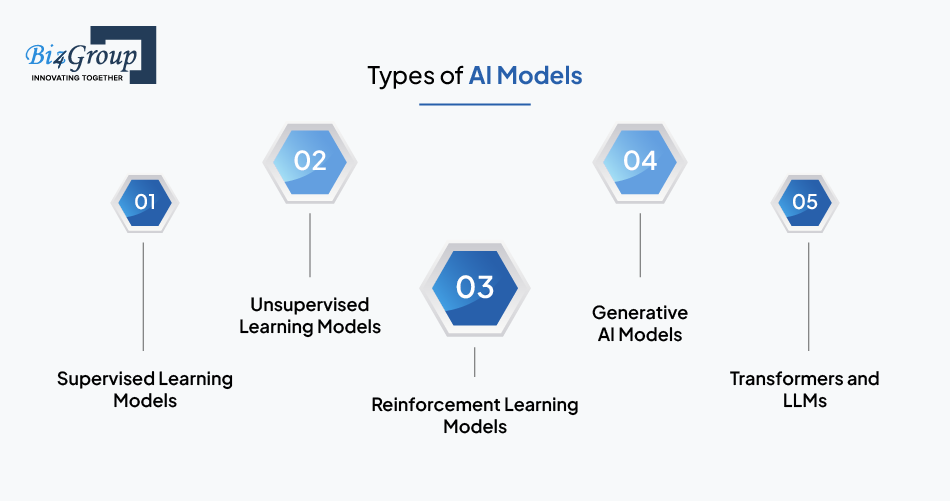
Every successful AI project starts with the right model choice. But if you're still stuck between "supervised or unsupervised?" or wondering if a large language model is worth the hype—you're not alone.
Here’s what you need to know, minus the jargon and guesswork.
Think of this as "learning with a teacher." These models are trained on labeled data—where the correct answers are known. The system learns patterns and relationships between input and output, and uses that to make future predictions.
Common use cases:
Supervised models are ideal when you have clear historical data and want to develop an AI model that makes accurate forecasts or decisions based on that data.
No labeled answers here. These models are used when you want the AI to discover hidden patterns or groupings within raw data.
Use cases include:
Great for businesses sitting on tons of unstructured data but unsure how to act on it. These models help you build intelligent AI model frameworks that surface unseen opportunities.
This is the "trial and error" model. It learns by taking actions and receiving rewards or penalties based on outcomes.
Where it works:
These models evolve in real-time, adjusting their behavior to reach better outcomes over time—perfect for highly dynamic environments.
Now we're in “creator mode.” Generative AI agents don’t just analyze—it builds. These models can write, code, design, synthesize voices, and more.
Practical uses:
With strategic generative AI model development, businesses can automate content creation, reduce manual load, and personalize user experiences at scale.
If you're looking to launch these capabilities, it’s smart to partner with an AI app development company that understands both tech and business outcomes.
This is where things go from smart to scary smart.
Transformers (the architecture behind models like GPT-4) are the brains powering large language models (LLMs). These models excel at natural language understanding, text generation, summarization, translation, and even coding.
Why LLMs matter for businesses:
LLMs are key when you're creating AI models from scratch for companies that interact heavily through text—think legal, SaaS, eCommerce, and support-heavy industries.
And when LLMs are embedded as part of a broader ecosystem—through custom AI model development—they become much more than chatbots. They become virtual teammates.
We’ll help you pick (and build) the model that doesn’t just think—it delivers.
Let's TalkBuilding an AI model from scratch isn’t a one-and-done process—it’s a pipeline. A sequence of interconnected layers that work together like a well-oiled machine.
When one layer breaks, performance suffers. When each layer is dialed in? That’s when businesses see real transformation from AI model development.
Let’s unpack the 5 key layers your team needs to get right.
This is your foundation—the tech stack that holds everything up.
Think cloud infrastructure, compute power, storage, GPU availability, and network architecture. Without a reliable system layer, you can’t scale models or support the high-throughput demands of real-time inference.
For most enterprises and startups, this means working with a custom software development company that can architect scalable environments using tools like Kubernetes, Docker, and serverless APIs.
Key considerations:
This layer feeds the model.
It handles raw data ingestion—whether it's from sensors, customer apps, CRMs, IoT devices, emails, or eCommerce logs.
Your model is only as smart as the data it sees. And if garbage goes in? Garbage comes out. Every time.
Typical sources include:
This is where creating AI models from scratch for companies gets tricky—most orgs have messy, siloed data scattered across departments. That’s why getting the Input Layer right is step one in every AI model development roadmap for organizations.
Once the data flows in, it’s time to clean, label, normalize, and prep it for model training.
This stage includes:
Mess this up, and you’ll end up developing an AI model that looks smart during testing and fails miserably in production.
Bonus: At this stage, many companies also integrate AI automation services for faster annotation and preprocessing workflows.
This is where the magic (and math) happens.
The Learning Layer houses your models—supervised, unsupervised, generative AI, or even custom transformer stacks. Here’s where you architect, train, validate, and optimize.
You’ll:
If you’re serious about developing an AI model that performs under real-world conditions, your learning layer needs more than just "good code." It needs strategy.
The final frontier. This is where the model interfaces with your actual business.
Whether it’s pushing predictions to dashboards, APIs, mobile apps, or backend services—this layer makes the AI model usable by people or systems.
Delivery must be:
A well-structured delivery layer ensures your build intelligent AI model initiative doesn’t end up in “POC purgatory.”

Successful AI model development doesn’t happen in a weekend hackathon. It's a structured journey—from raw idea to real-world execution.
Whether you're a startup founder, a CIO, or leading a product team, here’s how to develop an AI model the right way—without wasted time, budget burn, or false starts.
Every model starts with clarity—not code.
“We want AI” isn’t a use case. “We want to reduce average support response time by 50%” is.
No clean data = no smart model.
At this point, many teams leverage AI integration services to streamline complex, multi-source data flows into one model-ready pipeline.
This is where AI model development gets technical—and fun.
For customer-facing solutions, like virtual agents, partnering with an AI chatbot development company ensures your model not only works—but speaks fluently with users.
Now you're in model boot camp.
This is where you’re truly developing an AI model to handle real-world messiness—not just clean test data.
Deployment is where most AI projects die. Don’t let yours.
This is a critical step in creating AI models from scratch for companies that need enterprise-grade reliability.
Your AI model isn’t a “launch and forget” tool—it evolves.
If your long-term vision involves scalable AI model development for startups or growing teams, build these feedback loops early.
We turn AI blueprints into actual, working solutions—minus the headaches.
Contact UsChoosing the right tech stack for your AI model development isn’t about picking the flashiest tools—it’s about matching the right platforms to your data, goals, and business environment.
Whether you're developing an AI model in-house or scaling up a team for enterprise deployment, your stack should support performance, scalability, collaboration, and maintainability.
Here’s a breakdown of what to use—and when:
|
Phase |
Recommended Tools |
Purpose |
|---|---|---|
|
Data Collection & Prep |
Python, Pandas, Apache Kafka, Airbyte, Snowflake |
Collect, stream, and warehouse structured/unstructured data |
|
Data Labeling |
Labelbox, SuperAnnotate, Amazon SageMaker Ground Truth |
Annotate data for supervised learning and classification tasks |
|
Model Architecture |
TensorFlow, PyTorch, Keras, JAX |
Frameworks for custom AI model development including deep learning and neural networks |
|
Generative AI Models |
Hugging Face Transformers, LangChain, OpenAI APIs |
Build and fine-tune generative AI model development projects (chatbots, content generation) |
|
Model Training & Tuning |
MLflow, Optuna, Ray Tune |
Track experiments, tune hyperparameters, manage metrics |
|
Deployment |
Docker, Kubernetes, TorchServe, TensorFlow Serving |
Package and deploy models as services that scale in production environments |
|
Monitoring & MLOps |
Evidently AI, Arize, Prometheus, Grafana, DataDog |
Detect drift, latency issues, performance drops—crucial for live environments |
|
App Layer Integration |
FastAPI, Flask, Node.js, gRPC |
Interface for connecting models to applications and external systems |
|
UI / UX Layer |
React, Vue.js, Figma, UI/UX design |
Create seamless, user-friendly experiences on top of intelligent systems |
A patchy tech stack leads to bottlenecks, cost overruns, and inconsistent model performance. The right tools help you:
Building a production-ready AI model isn’t cheap—but it’s also not some black box of unlimited spend.
On average, AI model development for enterprise-grade solutions ranges from $80,000 to $500,000+, depending on complexity, data volume, team structure, and whether you're training from scratch or using pre-trained models.
Let’s break it all down.
|
Development Phase |
Estimated Cost Range (USD) |
What’s Included |
|---|---|---|
|
Business Use-Case Framing |
$5,000 – $15,000 |
Workshops, stakeholder alignment, goal definition |
|
Data Collection & Labeling |
$10,000 – $50,000+ |
Internal data prep, 3rd-party data, annotations, labeling tools |
|
Model Design & Architecture |
$15,000 – $70,000+ |
Framework selection, architecture planning, algorithm evaluation |
|
Model Training & Testing |
$20,000 – $100,000+ |
Training, validation, tuning, performance optimization |
|
Deployment & MLOps |
$10,000 – $60,000+ |
CI/CD setup, APIs, containerization, model registry, drift monitoring |
|
Monitoring & Maintenance |
$5,000+/month ongoing |
Continuous updates, retraining, performance dashboards |
These can sneak up if you’re not planning for the long game:
Want to cut your time-to-market without breaking the bank? Partnering with teams that specialize in developing an AI model end-to-end can reduce costs significantly—especially if they offer integrated UI, backend, and deployment under one roof.
Smart strategy beats big spend. We’ll help you stay lean and launch fast.
Schedule a Free Call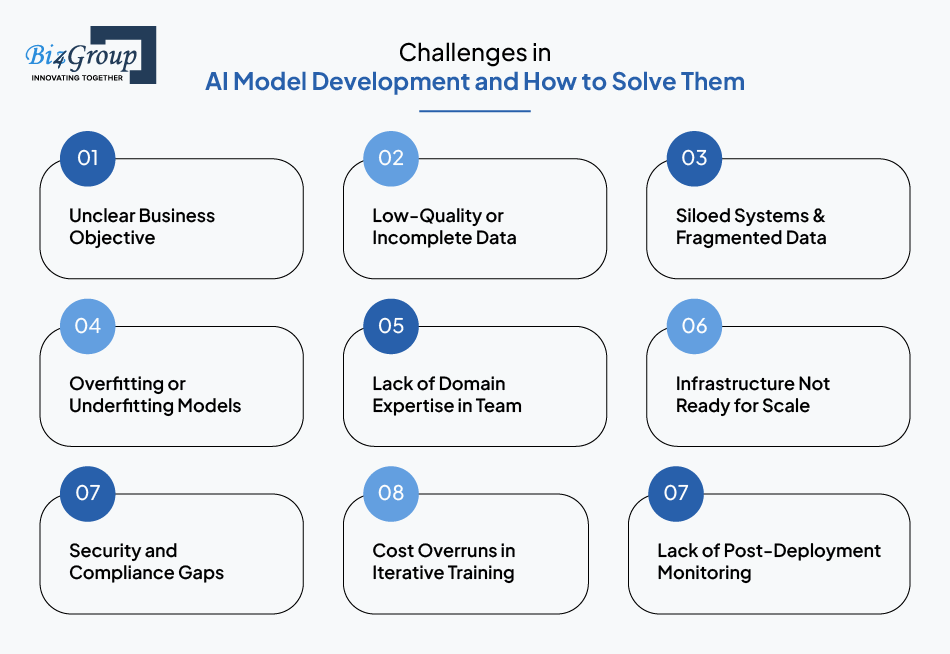
Even the most promising AI model development projects can crash and burn if common enterprise roadblocks aren’t addressed early. From messy data to deployment disasters—most issues aren’t technical at their core… they’re strategic.
Below is a breakdown of the most common challenges enterprises face and how to overcome them without blowing the budget or timeline.
|
Challenge |
What Happens |
Solution |
|---|---|---|
|
Unclear Business Objective |
Models are built… but solve nothing valuable |
Define use-case ROI before even selecting the algorithm |
|
Low-Quality or Incomplete Data |
Garbage in = garbage out |
Invest early in data cleansing, validation, and enrichment |
|
Siloed Systems & Fragmented Data |
Hard to train accurate models or automate workflows |
Use centralized data lakes + APIs with support from AI consulting services |
|
Overfitting or Underfitting Models |
Great in test. Terrible in production. |
Monitor training with robust validation and live feedback loops |
|
Lack of Domain Expertise in Team |
Misaligned models that don’t reflect business context |
Involve SMEs and business leads in the AI model development roadmap for organizations |
|
Infrastructure Not Ready for Scale |
Models fail under load or during updates |
Build with cloud-native, containerized deployment from day one |
|
Security and Compliance Gaps |
Legal risks, especially in finance/healthcare |
Bake in regulatory checks (HIPAA, GDPR) from architecture phase |
|
Cost Overruns in Iterative Training |
Endless tuning cycles with no output |
Set performance thresholds and limit experiments using AutoML tools |
|
Lack of Post-Deployment Monitoring |
Models decay over time and deliver bad predictions |
Integrate continuous monitoring tools like Arize, Prometheus, and retraining workflows |
Launching a model is exciting. Sustaining it? That’s where the real work begins.
Whether you're building your first model or scaling across departments, these best practices ensure your AI model development process remains reliable, maintainable, and impactful long-term.
Applying an MVP development strategy ensures faster feedback loops and avoids wasting time on low-value experiments.
AI is evolving fast—and so is how businesses use it. What worked in 2022 won’t cut it in 2025 and beyond. To stay competitive, leaders must understand what’s next in AI model development, and more importantly, how to prepare for it now.
Here are the key trends shaping the future:
We're moving from predictive analytics to generative AI model development—models that don’t just analyze, but actually create.
Think dynamic product content, customer replies, personalized video scripts—all AI‑generated and human‑like. For companies aiming to build an AI app, integrating generative workflows is fast becoming a baseline.
Agentic AI is rising—systems that can make multi-step decisions, take action, and improve without being told.
These aren't just smart tools; they're autonomous co-workers. Embedding such logic into enterprise systems requires robust AI model development frameworks that combine logic, data, and real-time context.
The future is not just text or image—it’s both. Creating AI models from scratch for companies will increasingly mean integrating text, audio, vision, and sensor data into unified models.
Multimodal AI unlocks richer predictions and better customer experiences across industries.
Generic models are out. Tailored, industry-specific models are in.
From law firms to manufacturing to retail, enterprises are focusing on custom AI model development that understands sector nuances. It’s the future of serious business app development using AI.
As models gain influence, they’ll face more regulation. That means explainability, fairness, and bias checks won't be “nice-to-have”—they’ll be requirements. Developing an AI model that’s scalable and compliant will require proactive documentation and built-in governance.
It’s no longer just about data scientists. Businesses now need model trainers, prompt engineers, MLOps experts, and domain-savvy architects.
Forward-thinking orgs are already partnering with the top AI development companies in USA to cover end-to-end AI execution—fast, secure, and scalable.
When your organization decides to invest in AI model development, choosing the right partner can make or break the project. Biz4Group combines deep technical expertise, cross-industry experience, and a mastery of enterprise-grade delivery to ensure your model thrives—beyond just launch.
You can hire AI developers from us to become an extension of your team. They specialize in LLM fine-tuning, MLOps, edge deployment, and everything it takes to integrate intelligent systems at scale.
Key Projects That Showcase Our Capabilities in Integrating AI Models
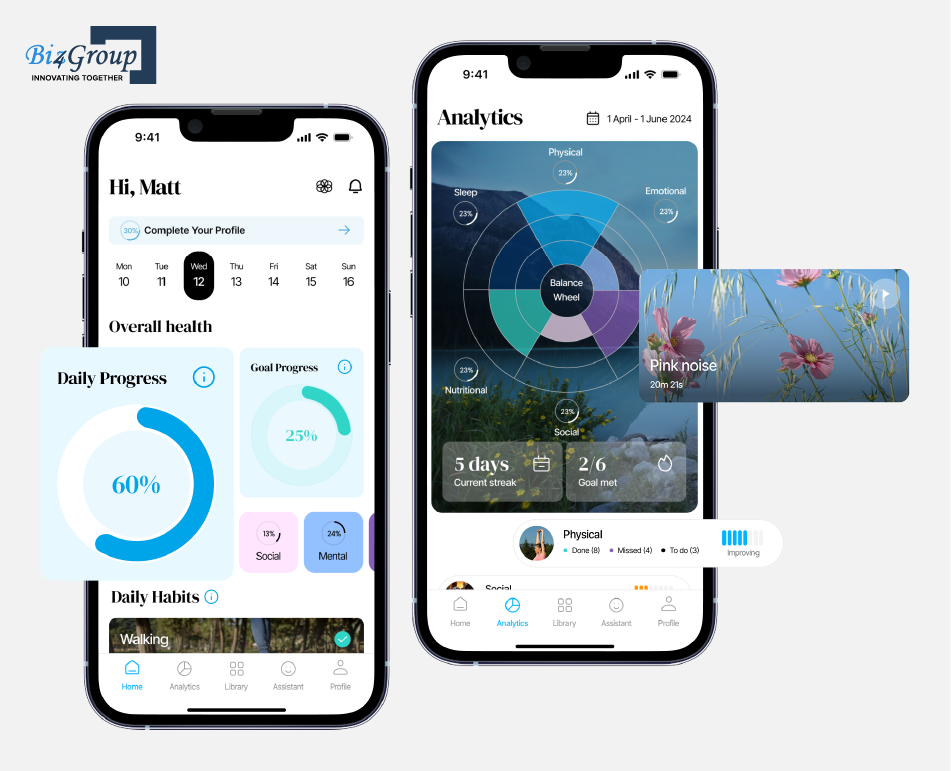
Qunantum Fit, a fitness and nutrition coaching app powered by AI algorithms that create personalized meal plans and workout routines. Users receive dynamic feedback based on their biometric inputs and activity data.
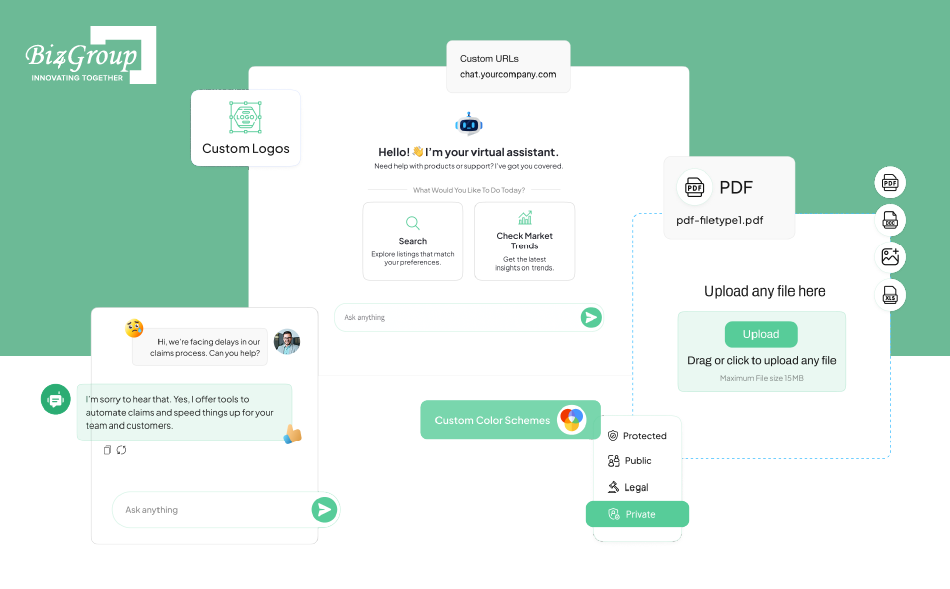
A custom enterprise AI agent is an intelligent assistant who automates complex internal workflows—such as meeting summaries, document retrieval, and task reminders—using fine-tuned LLMs and real-time API integrations.
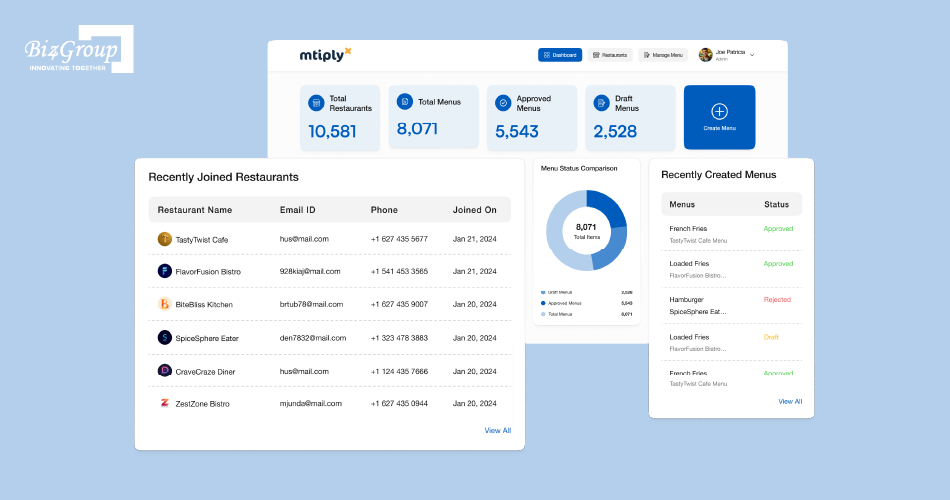
Mtiply is an AI-powered menu management system for cloud kitchens, designed to analyze ingredient availability and consumer demand trends. It auto-generates optimized menus and allows admins to customize items based on cost and popularity.
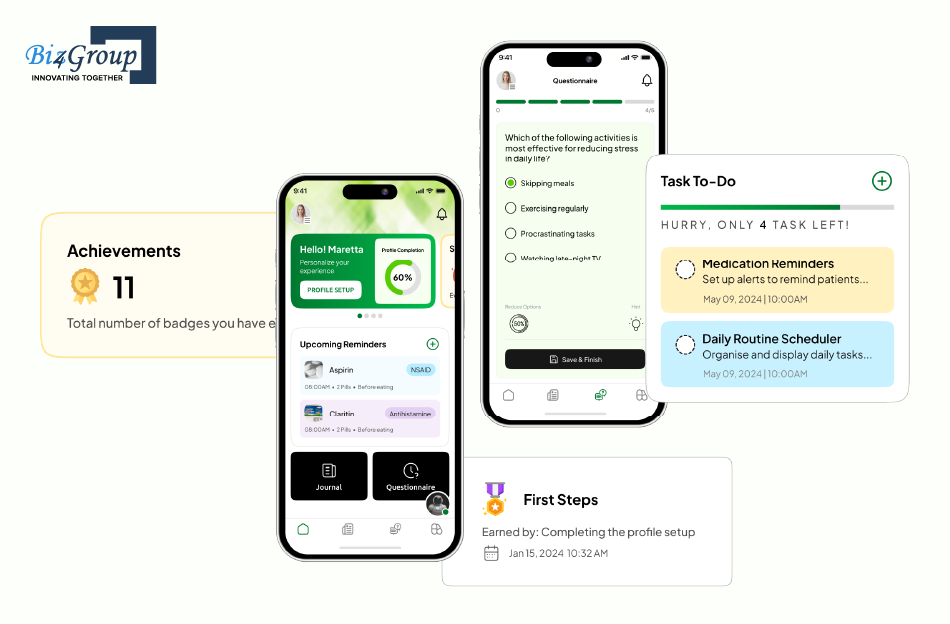
CogniHelp is a mobile app built for early- to mid-stage dementia patients. It provides tailored memory prompts, interactive quizzes, voice-to-text journaling, and cognitive performance tracking—supporting mental health and daily routines.
Across every engagement, we employ custom AI model development, generative AI model development, and scalable AI model development for startups and enterprises—making sure your deliverables are purposeful and future-ready.
From custom agents to predictive systems, Biz4Group delivers AI model development solutions that are built to scale. We fill your capability gaps, introduce processes that align with enterprise strategy, and empower your team to own the outcome.
From LLMs to live deployment—we’ve done it, scaled it, and made it work.
Let's Talk AIAs AI continues to shape the future of business, the companies that win won’t be the ones who dabble—they’ll be the ones who build with intention. From strategy to deployment, successful AI model development requires more than algorithms. It demands domain expertise, clean infrastructure, responsible data handling, and the ability to evolve with market shifts.
At Biz4Group, we don’t just create AI—we build intelligent systems that solve real problems. Our work in custom AI model development, generative AI model development, and developing AI models for complex enterprise environments has helped businesses turn vision into velocity.
If you're ready to create models that don’t just function—but fuel transformation—Biz4Group is the partner built for that mission.
Let’s build something smarter, together.
AI model development is the process of designing, training, and deploying machine learning models that help businesses automate decisions, make predictions, or generate content. Companies need it to streamline operations, improve customer experience, and gain a data-driven edge over competitors.
The cost of custom AI model development can range from $80,000 to $500,000+, depending on the complexity, data requirements, and deployment scale. Factors like industry, infrastructure, and model type also play a big role.
If your use case is niche or requires proprietary logic, creating AI models from scratch for companies is ideal. For faster time-to-market, fine-tuning a pre-trained model may be more cost-effective—especially for generative AI tasks.
Integration involves APIs, middleware, or direct application embedding, depending on your tech stack. Partnering with a company offering robust AI integration services ensures seamless model deployment within your operations.
Absolutely—if built right. Scalable AI model development for startups and enterprises includes modular design, cloud-native deployment, and automated monitoring, all of which help your model grow with your business.
That depends on the use case. Predictive models typically need structured historical data, while generative AI model development may require large sets of text, images, or other creative content. Clean, labeled data = better outcomes.
Biz4Group combines deep technical skill with enterprise understanding. We specialize in AI model development, custom AI model development, and full-stack delivery—from concept to launch. Plus, our portfolio proves it: real projects, real results.
with Biz4Group today!
Our website require some cookies to function properly. Read our privacy policy to know more.